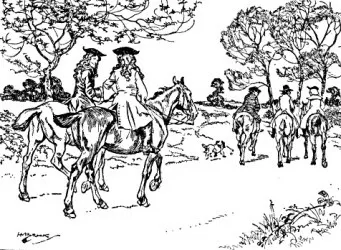About the author
JOSEPH ADDISON (1672-1719)
He was an English essayist, poet, playwright and politician.
Notable Classic Scholar.
Deeply influenced by Latin poetry
His name is usually remembered alongside that of his long-standing friend Richard Steele.
In collaboration with Richard Steele, Addison published the periodical THE SPECTATOR from 1711 - 1714 appearing thrice weekly for six months.
Declared the aim of The Spectator to "enliven morality with wit and to temper wit with morality"
Addison's other notable literary production during this period was his tragedy Cato (1713) - blank verse tragedy- themes are relevant to Addison's age: individual liberty versus govt tyranny, Republicanism versus Monarchism etc.
Early verse The Campaign (1704)
Summary
The essay begins with an explanation of how Sir Roger is the best kind of man in his life. He has endeared himself to all his neighbours by his kindness and pleasing behaviour. A man is at peace with himself when he has a clear conscience and the approval of the public. Sir Roger is one who has both.
The narrator then recalls an incident when the old knight took him and Will Wimble, a man about town, to attend a court sitting in the country. They meet two gentlemen on the way and as they ride; Sir Roger tells the narrator about them.
While Will Wimble and the two gentlemen ride a little ahead, Sir Roger explains that one of them is a farmer. The latter would have been a good neighbour, except that he shoots down too many partridges for food. The other man, Tom Touchy, is notorious for his habit of taking legal action against everybody. He prosecuted two honest men for something as trivial as passing and destroying some of his hedges. He had to sell the land the hedges enclosed to meet the cost of the lengthy prosecution. His obsession with litigation has ruined him financially but he refuses to desist.
Wall Wimble and Tom Touchy wanted Sir Roger's opinion on a point of view regarding a trivial incident about Wimble fishing in the river. The men had opposing opinions, but Sir Roger pronounced with an air of judicial solemnity that "much might be said on both sides". This verdict. not holding either person guilty satisfied them.
The proceedings of the court had already started by the time Sir Roger and his companions reached. When the sessions were about to end, the knight stood up and made a short speech. The speech was insignificant, but its purpose had not been to inform the court about anything, but only to impress the author and the assembly.
On the way back, the group stopped at an inn to refresh themselves. The inn was owned by a former servant of Sir Roger. As a mark of respect to his master, this man had painted Sir Roger's head on the inn's signpost without informing him. When he came to know of it, Sir Roger had arranged the features on this painting to be altered to resemble a frowning Saracen. The altered painting was brought in, but it still resembled him When Sir Roger wanted the author to tell him whether or not the monstrous picture looked like his, the narrator, exercising the same diplomacy that the knight had employed earlier, said "Much might be said on both sides."
SPECTATOR CLUB
Introduced in the second number of The Spectator
A fictitious London Club with imaginary members
"Mr Spectator, one of the fictional characters, an observer of London society, allegedly wrote papers.
Their imaginary conversations provided opinions in manners, morals, art and literature
Mild witty portrait of members.
These members represent important sections of society. Steele describes six of the members of the Club as Sir Roger de Coverley, Captain Sentry, Sir Andrew Freeport, Will Honeycomb, the Clergyman and the Student of Law.
Sir Roger De Coverley
The principal character of Addison's essays, was in fact, not the creation of his but of his friend, Richard Steele’s. In the essay of the club, Steele gave us the bare sketch of the basic characteristics of Sir Roger de Coverley, an imaginary eccentric old country knight who frequented the Spectator Club in London. But what proficiency goes to Addison, is that he gave the character life, interest, and adventure, and cast over it the charm of his pleasant humour. Thus, Sir Roger occupied the prime place in most of the essays of Addison.
Sir Roger, as portrayed by Steele and Addison, was a bachelor, although he had a family which consisted of sober and grave servants of his. Sir Roger was the best master, all in all, in his family. He seldom changed his servants. So, all the members were aged and grew old with Sir Roger. Sir Roger's behaviour to them was all along good. His kindness and love went equally even in the treatment of his old dog and old grey horse. None of both the creatures was useful, yet they were kept with great care and tenderness regarding their past services.
Characters
The narrator, Sir Roger, Will Wimple, Yeoman, Tom Touchy, Servant etc...
Sir Roger at Assizes begins with the dictum that a man enjoys peace of mind when his conscience is clear and when his community appreciates his conduct.
The narrator illustrates the maxim with the actions of Sir Roger at a Country sessions court.
He concludes the picture with the episode at the inn which exposes a ridiculous aspect of his character
The narrator recalls a few instances of the general respect shown to Sir Roger when he and Mr Will Wimble travelled with Sir Roger to attend a court session.
